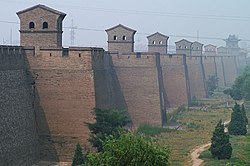Pingyao
Pingyao (Chinese: 平遥; pinyin: Píngyáo) is a Chinese city and county in central Shanxi province. It lies about 715 km from Beijing and 80 km from the provincial capital, Taiyuan. During the Qing Dynasty, Pingyao was a financial center of China. It is now renowned for its well-preserved ancient city wall, and is a UNESCO World Heritage Site.
Historical importance
Pingyao still retains its city layout from the Ming and Qing dynasties, conforming to a typical bagua pattern. More than 300 sites in or near the city have ancient ruins. Preserved Ming- and Qing-style residences number close to 4,000. The streets and storefronts still largely retain their historical appearance.
In the Spring and Autumn Period, the county belonged to the kingdom of Jin. It was part of the kingdom of Zhao in the Warring States Period. In the Qin Dynasty, it was known as Pingtao. During the Han Dynasty, it was known as Zhongdu county. In 1986, the People's Republic of China designated Pingyao as one of the Chinese Historic and Cultural Cities. It became a World Heritage Site in 1997, included also the outlying Zhenguo Temple and Shuanglin Temple.
City walls

The city walls of Pingyao were constructed in the 3rd year of the Hongwu Emperor (1370). The walls have six barbican gates. The north and south sides have one gate each. The east and west sides have two gates each. This pattern is similar to that of a turtle (the head, tail, and four legs), earning Pingyao the moniker "Turtle City." The walls measure about 12 meters high, with a perimeter of 6,000 meters. A 4-meter wide, 4-meter deep moat can be found just outside the walls. Aside from the four structured towers at the four corners, there are also 72 watchtowers and more than 3,000 battlements. In 2004, part of the southern walls collapsed but were reconstructed. However, the rest of the city walls are still largely intact and are considered among the best-preserved ancient city walls on this scale. This makes the city walls the centerpiece of the Heritage Site.
Finance

Pingyao was the financial center of China in the late Qing Dynasty. During those times, there were as many as 20 financial institutions within the city, comprising more than half of total in the whole country. Among these is "Rishengchang," considered the first bank in China.
Geography and economy
Pingyao is located on the eastern banks of the Fen River, and is in the southwestern edge of the Taiyuan basin. It is adjacent to another Chinese Historic and Cultural City Qi County. Pingyao's economy is largely agricultural and the region is famed for its beef. Other products from the region include grains, cotton, and lacquerware.
Miscellaneous
The 1992 movie Raise the Red Lantern was shot in the Qiao's Compound of Pingyao.
Bicycles are the main mode of transportation, because cars are restricted.
References
- This article incorporates material translated from the articles 平遥 and 平遥城墙 from the Chinese Wikipedia, retrieved on May 10, 2005.
More Images
External links





